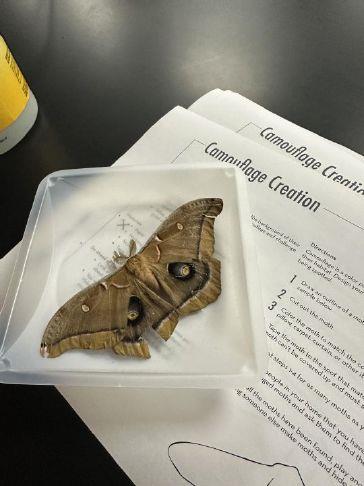One might think that a moth… is just a moth. Like the kind that hover around the porch light, and then come in the house when the door is open. Now, consider the Atlas Moth from Asia, or the Luna Moth from Mexico, both of which can grow to a wingspan of up to 7 inches. But it’s not the size of the moth that is the focus of Elizabeth Gibbs’ Denison High School AP Biology students. The lesson focuses on the colorations and patterns of the wings of the moth, and how they blend in with their environment as a source of self-preservation.
“I really hit hard on the types of natural selection all organisms have, and one of them is mimicry in animals. We use the Peppered Moth from the industrial Revolution and how that moth changed so quickly because of pollution. It was white, and then over about a year, one little, tiny mutation changed that moth species to a dark gray because of the pollution of the Industrial Revolution,” said Gibbs.
The AP biology students in Gibbs’ classes create their own paper cutout moth, colored and designed to mimic a texture or pattern found somewhere inside the DHS campus. It could look like brick, or tile, or even a leaf on a silk plant. They then take their moth and affix it to that textured spot they patterned their moth after, photograph it, and document its location.
“We’re coloring moths to camouflage them. The natural selection comes in whether your moth is disguised enough or if it’s visible. If the moth isn’t found it stands a chance of living. If the moth is found, it stands a chance of dying,” said DHS sophomore Zoey Moore.
The AP Biology students pick up on the lesson quickly as they prepare their individual moths for hiding, which other students will then seek out. Sophomores Itzaak Villalobos and Jude Pollaro hid one of their moths in a spot nearly identical to the color scheme they designed.
“From a real-life standpoint, the coloring of the moth helps it hide from predators. It’ll help it survive longer,” Villalobos said.
For Gibbs, teaching this lesson on natural selection is more than just about whether a moth lives or not, it’s about helping her students learn adaptation to the environment in which one exists.
“It doesn’t have to be an evolutionary adaptation, but just them adapting to different environments. Maybe your workplace has a uniform. You may have to change what you
wear to fit in and benefit in that new environment. I say in my class, that’s how life is. Like the moth, you can adapt and change or you can migrate or move. There’s going to be some failures, but you can learn from those failures,” Gibbs said.
Students in Gibbs’ class say they learn how this lesson becomes beneficial in their lives by developing critical-thinking skills they can utilize throughout their lives.
“We can reflect upon ourselves in the environments where we live. When you grow as a person, it’ll help you change in that environment. So, as you mature, it’ll help you develop into the adult world more. The moths we’re studying will survive with their adjustments so they can live on and reproduce and make sure the next generation can live on,” said sophomores Emily Baca and Juliana Torres.




